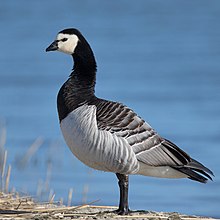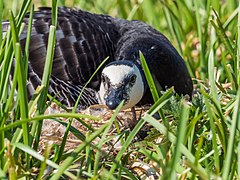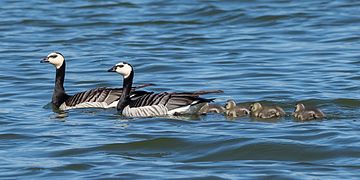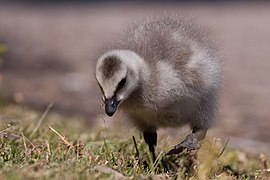
A goose is a bird of any of several waterfowl species in the family Anatidae. This group comprises the genera Anser and Branta. Some members of the Tadorninae subfamily are commonly called geese, but are not considered "True Geese" taxonomically. More distantly related members of the family Anatidae are swans, most of which are larger than true geese, and ducks, which are smaller.

The nene, also known as the nēnē or the Hawaiian goose, is a species of bird endemic to the Hawaiian Islands. The nene is exclusively found in the wild on the islands of Oahu, Maui, Kauaʻi, Molokai, and Hawaiʻi. In 1957, it was designated as the official state bird of the state of Hawaiʻi.

The greylag goose or graylag goose is a species of large goose in the waterfowl family Anatidae and the type species of the genus Anser. It has mottled and barred grey and white plumage and an orange beak and pink legs. A large bird, it measures between 74 and 91 centimetres in length, with an average weight of 3.3 kilograms. Its distribution is widespread, with birds from the north of its range in Europe and Asia often migrating southwards to spend the winter in warmer places, although many populations are resident, even in the north. It is the ancestor of most breeds of domestic goose, having been domesticated at least as early as 1360 BCE. The genus name and specific epithet are from anser, the Latin for "goose".

The pink-footed goose is a goose which breeds in eastern Greenland, Iceland, Svalbard, and recently Novaya Zemlya. It is migratory, wintering in northwest Europe, especially Ireland, Great Britain, the Netherlands, and western Denmark. The name is often abbreviated in colloquial usage to "pinkfoot". Anser is the Latin for "goose", and brachyrhynchus comes from the ancient Greek brachus "short" and rhunchos "bill".

The lesser white-fronted goose is a goose closely related to the larger greater white-fronted goose. It breeds in the northernmost Palearctic, but it is a scarce breeder in Europe, with a reintroduction attempt in Fennoscandia.

The snow goose is a species of goose native to North America. Both white and dark morphs exist, the latter often known as blue goose. Its name derives from the typically white plumage. The species was previously placed in the genus Chen, but is now typically included in the "gray goose" genus Anser.

The red-breasted goose is a brightly marked species of goose in the genus Branta from Eurasia. It is currently classified as vulnerable by the IUCN.

The Canada goose, sometimes called Canadian goose, is a large wild goose with a black head and neck, white cheeks, white under its chin, and a brown body. It is native to the arctic and temperate regions of North America, and it is occasionally found during migration across the Atlantic in northern Europe. It has been introduced to France, the United Kingdom, Ireland, Finland, Sweden, Denmark, New Zealand, Japan, Chile, Argentina, and the Falkland Islands. Like most geese, the Canada goose is primarily herbivorous and normally migratory; often found on or close to fresh water, the Canada goose is also common in brackish marshes, estuaries, and lagoons.

The emperor goose, also known as the beach goose or the painted goose, is a waterfowl species in the family Anatidae, which contains the ducks, geese, and swans. In summer, the emperor goose is found in remote coastal areas near the Bering Sea in arctic and sub-arctic Alaska and the Russian Far East, where it breeds in monogamous pairs. It migrates south to winter in ice-free mudflats and coasts in Alaska, mostly the Aleutian Islands, and Canada's British Columbia, rarely reaching the contiguous United States. Listed as near threatened by the International Union for Conservation of Nature, the species' population is declining due to threats such as pollution, hunting, and climate change.

The black geese of the genus Branta are waterfowl belonging to the true geese and swans subfamily Anserinae. They occur in the northern coastal regions of the Palearctic and all over North America, migrating to more southerly coasts in winter, and as resident birds in the Hawaiian Islands. Alone in the Southern Hemisphere, a self-sustaining feral population derived from introduced Canada geese is also found in New Zealand.
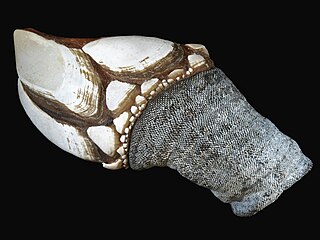
Goose barnacles, also called stalked barnacles or gooseneck barnacles, are filter-feeding crustaceans that live attached to hard surfaces of rocks and flotsam in the ocean intertidal zone. Goose barnacles formerly made up the taxonomic order Pedunculata, but the group has been found to be polyphyletic, with its members scattered across multiple orders of the infraclass Thoracica.

The spur-winged goose is a large, Sub-Saharan African waterbird in the family Anatidae, which includes geese and shelducks. However, P. gambensis developed unique environmental adaptations, which resulted in the evolution of several anatomical features that are not shared with other anatids; thus, the species has been classified one step further into its own subfamily, the Plectropterinae.

Ross's goose, formerly Chen rossii, is a white goose with black wingtips and a relatively short neck. It is the smallest of the three white geese that breed in North America. It is similar in appearance to a white-phase snow goose, but about 40% smaller. Other differences from the snow goose are that the bill is smaller in proportion to its body and lacks "black lips". Like snow geese, Ross's geese may exhibit a darker "blue" phase or morph, though this is extremely rare.

The cackling goose is a species of goose found in North America and East Asia.

The brant or brent goose is a small goose of the genus Branta. There are three subspecies, all of which winter along temperate-zone sea-coasts and breed on the high-Arctic tundra.

The Aleutian cackling goose is a small subspecies of the cackling goose averaging 1.7 to 2.1 kg in weight. It was one of 122 species of animals, birds, and fishes first documented for science by the Lewis and Clark Expedition.

Søraust-Svalbard Nature Reserve is located in the south-eastern part of the Svalbard archipelago in Norway. The nature reserve covers all of Edgeøya and Barentsøya in addition to a number of smaller islands, including Thousand Islands, Ryke Yseøyane and Halvmåneøya. The reserve is 21,825 square kilometres (8,427 sq mi), of which 6,400 square kilometres (2,500 sq mi) is on land and 15,426 square kilometres (5,956 sq mi) is on water—making it the second-largest preserved area in Norway. The reserve has been protected since 1 July 1973 and borders the Nordaust-Svalbard Nature Reserve to the north.

Lepas anatifera, commonly known as the pelagic gooseneck barnacle or smooth gooseneck barnacle, is a species of barnacle in the family Lepadidae. These barnacles are found, often in large numbers, attached by their flexible stalks to floating timber, the hulls of ships, piers, pilings, seaweed, and various sorts of flotsam.
The dusky Canada goose is a subspecies of the Canada goose. They are the darkest variant, similar to the Pacific cackling goose. Tagged dusky geese have red bands with white letters on them attached to their neck. They represent one of the smallest populations of Canada goose in the Pacific Northwest. Due to the species' minimal population and exclusive breeding grounds, the dusky Canada goose is a species of interest to the Pacific Flyway Council and the U.S. Forest Service. The Cordova Ranger District, on the Chugach National Forest, has been working since 1984 to implement a monitoring and restoration program for the geese.

The barnacle goose myth is a widely-reported historical misconception about the breeding habits of the barnacle goose and brant goose. One version of the myth is that these geese emerge fully formed from goose barnacles (Cirripedia). Other myths exist about how the barnacle goose supposedly emerges and grows from matter other than bird eggs.
